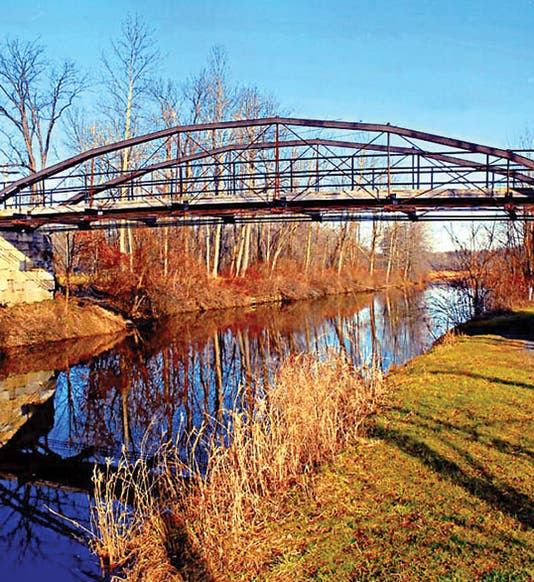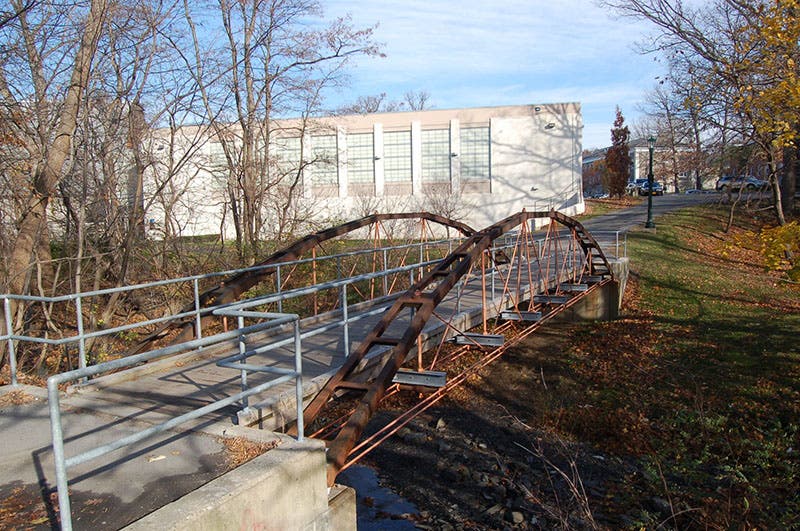Scientist of the Day - Squire Whipple
Squire Whipple, an American civil engineer, was born Sep. 16, 1804. Whipple was one of the first engineers in the United States to design truss bridges made of iron. He came of age when the Erie Canal was expanding from its original 40-foot width to 70 feet, which required a whole slew of new bridges across the canal. Before Whipple, wood was the material of choice of engineers for short and intermediate span bridges, because it was cheap and long lasting. Whipple thought there would be a market for an iron bridge that used minimum structural elements, could be constructed offsite, and then easily assembled (and disassembled) at its final destination. Wood worked well for the shorter span bridges because it has both compressive and tensile strength. But as spans increase, the weight of the wood itself increases dramatically, which makes it progressively uneconomic, and worse, the heavier wood members become an added deadweight that adds to the total weight the bridge must support.
Iron, however, varies in its ability to withstand compression and tension, depending on the manufacturing technique: cast vs. iron. Cast iron is excellent under compression and can support much more weight than wood. And it is cheap. But it has little tensile strength. Wrought iron, produced in a forge (and thus expensive), has excellent tensile strength, but is not especially strong under compression. So Whipple designed a new kind of small bridge, called a bowstring truss, where the bow, which carries the weight, is made of cast iron, and the "string" and the stays, which are under tension, are made of wrought iron. Moreover, he widened the cast-iron bow at the ends to help provide lateral stability, which in other bridges was provided solely by the roadway. You can see the elements of his bowstring truss from the drawing that accompanied his patent application of 1841 (second image).
Whipple had trouble convincing the Erie Canal authorities of the advantages of his bridge, so he built one at his own expense right next to the Canal, where they couldn't help but see it. When a wooden bridge collapsed, Whipple sold his iron bridge to the Canal, and before long there were hundreds of bowstring truss bridges crossing the canal, and quite a few streams, in New York state. Supposedly 7 survive today; a few are in use, with the others are on display. Union College in Schenectady, where Whipple went to school, moved a Whipple bowstring truss, originally in Johnstown, N.Y., to their campus in 1979, where it was re-erected to be part a pedestrian walkway (third image). You can see the commemorative plaque here. Another is the Vischer’s Ferry Bridge, originally at Sprakers, N.Y., and then moved to Cayadutta Creek in Fonda, N.Y, but now once again spanning the Eric Canal (first image). A third is the Normanskill Farm Bridge in Albany, which is also not at its original location. In all of these bridges, the inner rails on the roadway have been added and are not part of the original design.
Whipple wrote and self-published a book, A Work on Bridge Building (1847), which should have been in the Engineering Societies Library in New York City, but it did not come to us when we acquired that Library in 1995. An enlarged work, An Elementary and Practical Treatise on Bridge Building, was published in 1899, and we do have that book in our collections. We learn from his books that Whipple really understood forces and materials and how to calculate stresses, one of the first America bridge builders to have the mathematical skills to make such calculations. He truly was a mechanical engineer in the modern sense of the term.
Whipple also designed a through truss bridge that could carry the weight of railroad engines and trains. Here in Kansas City, the second bridge built over the Missouri River, the Chouteau Bridge, was a Whipple through truss, consisting of three spans, each 400 feet long; it opened in 1887. It stood until it was demolished in 2000 and replaced by a road traffic bridge.
Incidentally, the first bridge across the Missouri River in Kansas City was the Hannibal Bridge, designed by Octave Chanute and opened in 1869. We included this bridge in our exhibition of 2002, Centuries of Civil Engineering, and I have written a post on Octave Chanute, with the focus on the Kansas City Bridge.
Dr. William B. Ashworth, Jr., Consultant for the History of Science, Linda Hall Library and Associate Professor emeritus, Department of History, University of Missouri-Kansas City. Comments or corrections are welcome; please direct to ashworthw@umkc.edu.








